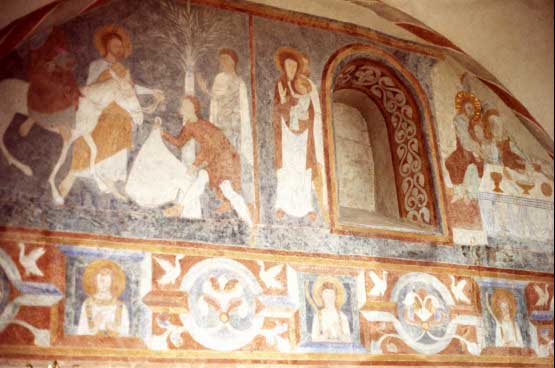UPDATE MARCH 1, 2010: New article with detailed information about the organ.
I have recently been hired as "organ consultant" - together with the organist of Jørlunde Church, Gunnar Svensson - for the construction of a new pipe organ. My job is to design the "list of stops" (disposition) and the tonal character of the organ, both overall and for the individual voices.
It all began when Gunnar Svensson asked me if I would like to join a competition held for the best disposition for a new pipe organ in Jørlunde Church. He had invited several organists (with special technical as well as musical knowledge of the instrument) to submit a proposition. I'm happy to say that he chose my suggestion
 A week later the Church Council asigned me as official organ consultant.
A week later the Church Council asigned me as official organ consultant.
Jørlunde Church (Sjælland, Denmark) was build around the year 1100 and is world renowned for it's amazingly well-kept medieval church wall paintings (chalk paintings) as seen here:

Church Wall Painting in Jørlunde Church, anno 1150 (bad photographic quality)
It is expected that the organ will completed sometime late this year (2005) or in the beginning of 2006. The architects Johannes and Inger Exner (whom - amongst countless other projects - was responsible for the re-contruction of the castle Koldinghus) has been assigned the job of drawing the organ facade and housing, but an organ-builder has not yet been chosen. Gunnar Svensson and I has had some very interesting meetings with the Exners.
It has been decided that the new organ must be of the highest quality, using the finest craftsmanship and materials. The total budget will be more than 450,000$ (US) but the result will be one of excellence and the instrument will be constructed to last at least 300 years - possibly much longer.
I cannot yet post the final stop list, because there may still be minor changes, but I will post it as soon as the construction has begun.
For now I can tell that the current (and probably final) disposition consists of 19 voices, 24 ranks and 1292 pipes ranging in height from a few centimeters to five meters (approx .16 feet). The organ will have two manuals (Great Organ + Swell Organ) and pedal.
I'm looking very much forward to the completion of this project and will keep your posted on the progress!

I have recently been hired as "organ consultant" - together with the organist of Jørlunde Church, Gunnar Svensson - for the construction of a new pipe organ. My job is to design the "list of stops" (disposition) and the tonal character of the organ, both overall and for the individual voices.
It all began when Gunnar Svensson asked me if I would like to join a competition held for the best disposition for a new pipe organ in Jørlunde Church. He had invited several organists (with special technical as well as musical knowledge of the instrument) to submit a proposition. I'm happy to say that he chose my suggestion

Jørlunde Church (Sjælland, Denmark) was build around the year 1100 and is world renowned for it's amazingly well-kept medieval church wall paintings (chalk paintings) as seen here:

Church Wall Painting in Jørlunde Church, anno 1150 (bad photographic quality)
It is expected that the organ will completed sometime late this year (2005) or in the beginning of 2006. The architects Johannes and Inger Exner (whom - amongst countless other projects - was responsible for the re-contruction of the castle Koldinghus) has been assigned the job of drawing the organ facade and housing, but an organ-builder has not yet been chosen. Gunnar Svensson and I has had some very interesting meetings with the Exners.
It has been decided that the new organ must be of the highest quality, using the finest craftsmanship and materials. The total budget will be more than 450,000$ (US) but the result will be one of excellence and the instrument will be constructed to last at least 300 years - possibly much longer.
I cannot yet post the final stop list, because there may still be minor changes, but I will post it as soon as the construction has begun.
For now I can tell that the current (and probably final) disposition consists of 19 voices, 24 ranks and 1292 pipes ranging in height from a few centimeters to five meters (approx .16 feet). The organ will have two manuals (Great Organ + Swell Organ) and pedal.
I'm looking very much forward to the completion of this project and will keep your posted on the progress!




